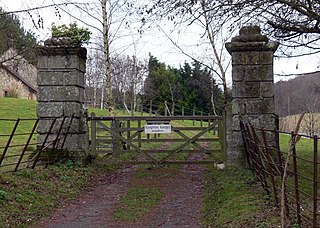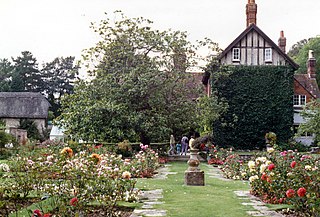Related Research Articles

The Gorges family was an Anglo-Norman family with lands in the southwest of England. They obtained the manors of Wraxall, Somerset and Bradpole in Dorset.

The Great Budbridge Manor is a manor house just south of Merstone, near Arreton, Isle of Wight, England. Fish ponds on the grounds appear medieval.

Knighton Gorges Manor was one of the grandest manor houses on the Isle of Wight. Located in the hamlet of Knighton, near Newchurch, it is reported to be one of the most haunted locations on the Isle of Wight.

Morton Manor is a manor house originating in the 13th century, in Brading, Isle of Wight, England. It is located 1 mile (1.6 km) southwest of Sandown Road. The 14th century fairly small house was modified in the 19th century. Constructed of varied materials, it was refurbished and extended in the early 20th century in an Arts and Crafts style. A Tudor fireplace is in the dining room, with William De Morgan green glazed tiles. The manor includes a small museum of rural life.
Ashey Manor is a manor house in Ashey on the Isle of Wight, situated within the Newchurch parish. It was historically linked with Ryde Manor.
Ryde Manor is a manor house in Ryde on the Isle of Wight, situated within the Newchurch parish. It was historically linked with Ashey Manor.
Langbridge Manor is a manor house on the Isle of Wight, situated within the Newchurch parish. It was historically linked with Ashey Manor.
Chillingwood Manor is a manor house on the Isle of Wight, situated within the Newchurch parish.
Haven Street Manor is a manor house on the Isle of Wight, situated at Havenstreet within the Newchurch parish.
Cleaveland Manor is a manor house on the Isle of Wight, situated within the Victoria parish.
Holloway Manor was a manor house on the Isle of Wight, situated within the Newchurch parish. It lies just to the north of Ventnor. It was held of the honour of Carisbrooke Castle and formed part of the estate of John de Lisle in the Island at the end of the 13th century. It followed the descent of South Shorwell until 1641, when it is mentioned for the last time. It is probably the same as the modern Ventnor Manor, which is mentioned for the first time in 1755 and then belonged to the Pophams of South Shorwell. Nearly all the land in Ventnor was sold in 1820 by the Hill family to John Hamborough and building speculators, and the manor no longer exists. Holloway can now only be identified by the Holy Well spring on the down, from which possibly the holding derived its name. In a dispute as to boundaries in 1617, witnesses deposed that Ventnor, Littletown and Holloway were tithings of themselves and that Sir Edward Dennis' ancestors kept court and law day at Holloway, where his tenants did suit royal.
Smallbrook Manor is a manor house on the Isle of Wight, lying at the north-eastern boundary of Newchurch parish. It doubtless took its name from the stream that here forms the boundary of the parish. It is of ancient origin, as in 1280 William de Smallbrook (Smalebrook) granted land to his son Hugh. It was held at the end of the 14th century by the Wyvill family, and remained in their possession until 1491–2, when Stephen Wyvill, the last of the family, sold it to Henry Howles. Smallbrook passed in the Howles family until the reign of Elizabeth, when it was divided between co-heirs and sold to Sir William Oglander. In the court held at Ashey Manor, 1 November 1624, Sir John Oglander was returned as a freeholder and free suitor of the manor for his farm called 'Smallbroke.' The estate has since descended with Nunwell and as of 1912 was held by Mr J. H. Oglander, who had the Court Rolls in his possession.
Winston Manor is a manor house on the Isle of Wight, situated in the Newchurch parish. Judging from the Domesday Book entries, it was an important manor held in part by the king and in part by William and Gozelin,sons of Azor. The king's portion formed two manors with a virgate of land in Soflet and was valued at £3, while the Azor land was held by six tenants and was worth 70s., which makes up a considerable holding if the entries refer to the same place. It seems to have early been among the endowments of Christchurch Twyneham, being confirmed to the convent by William de Redvers, Earl of Devon. In 1241 Richard Quor gave up to the prior all his right in the manor, and the priory still held it at the end of the century as a thirteenth part of a fee. Its further history is not known, but it came in the 19th century into the hands of Mr. Alfred Smith, and as of 1912 it was owned by his daughter's trustees.
Wroxall Manor was a manor house on the Isle of Wight, situated in the Newchurch parish.
Princelet Manor, is a manor house on the Isle of Wight, situated in the Newchurch parish. It a small holding to the south-west of Apse Heath, and was held by the Lisles of Wootton. Of them it was held by the Kingstons of Kingston until the middle of the 14th century. It was held in 1428 by Richard Hearn and John Mayhew. Princelet was purchased at the end of the 16th century by Richard Gard, who in 1617 left an annuity issuing out of it to the poor of Newchurch. In 1780 John White paid a fee-farm rent for it, but in 1837 it was owned by William Thatcher; the owner as of 1912 was Mr. Charles Allen.
Azor was one of the most powerful English landowners at the time of Edward the Confessor in the 11th century. He was a kinsman and chamberlain of Brihtheah, a bishop of Worcester and a former abbot of Pershore. He owned property from Lincolnshire down to the Isle of Wight in many counties and like another great landowner of the times, Toki, he also owned urban property in addition to his vast possession of lavish country estates. He is mentioned in the Domesday Book and appears in countless histories of English counties along with his sons, Goscelin, William, and Henry who inherited his estates after his death. The sons in particular are linked with the early histories of many of the major manor houses on the Isle of Wight.
Hale Manor is a manor house on the Isle of Wight, situated in the parish of Arreton. It forms the south-eastern portion of the parish adjoining Newchurch, and comprises the high ground to the south of the River Yar above Horringford.
Horringford Manor is a manor house on the Isle of Wight, situated in the parish of Arreton.
Barnsley Manor is a manor house in the parish of Brading on the Isle of Wight.
Borthwood Manor is a manor house in the parish of Brading on the Isle of Wight.
References
This article includes text incorporated from William Page's "A History of the County of Hampshire: Volume 5 (1912)", a publication now in the public domain
- 1 2 3 "Victoria County History". British History Online, University of London & History of Parliament Trust. 1912. Retrieved 6 July 2011.